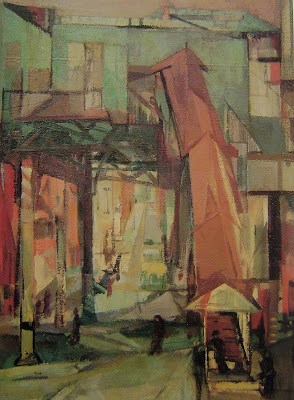 Would you have guessed this is a Franz Kline?
Would you have guessed this is a Franz Kline?He is so firmly associated now with his black and white abstractions that it came as a surprise to me to learn about his earlier years, scraping together enough money for materials and expenses, painting murals for restaurants. After studying art in Boston and England, he came to New York in 1938, and took a job at a women's clothing store. According to biographer Harry F. Gaugh, he was fired as a display designer after falling through a bridal window display.
The mural above was painted for the Bleeker Street Tavern in 1940.
Here's a later work, Chatham Square, 1948, with figures becoming
l
 ess important -seems to be all about the rectangles, the repeated shapes.
ess important -seems to be all about the rectangles, the repeated shapes.Always tricky to try to trace a line from an artist back to his influences, but Gaugh sees connections between Kline and Velasquez, Manet, Whistler, Mondrian, and others. Kline said:
You could say Manet and Velasquez - you see the coral world of Velasquez, his organization of the past - but their paintings don't 'influence' mine. It would take a top kind of egotist to say, 'Velasquez is related to what I'm doing.' So it's not a matter of rejecting the past, but if you fall more in love with it, your own painting escapes you. And of course if you want to paint you have to look at everything; you can't help seeing the past. (p. 128, Franz Kline by HF Gaugh)
Despite this warning, Gaugh suggests there's a link between Whistler's Arrangement in Grey and Black No. 1 (Whistler's Mother) and Kline's Painting No. 7:


Link? No link? What's your view?
When you're struggling every day to make decisions about color, composition, etc., I think it's interesting to hear an artist say he/she doesn't always feel completely in control of artistic choices. Kline did produce some paintings that included color, and apparently always had color on his palette. But here's this recollection of Leo Steinberg about Kline's 1956 show:
I remember his words to me - almost apologetic about having produced yet another show of mostly black paintings. 'I'm always trying to bring color into my paintings, but it keeps slipping away and so here I am with another black show.' What struck me about that statement was the passivity of the formulation; as though blackness were happening to him by force-majeur - something he had no control over. (p.132.)
Here's a detail from Andrus, 1961. You see Kline clones often enough, but I don't know - I think there's something that's just right about his work, something physical and bold, that sets his apart.





No comments:
Post a Comment